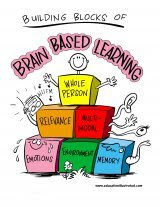The brain and learning can sometimes seem like an overwhelming topic of discussion. We will take an in-depth look at the basic function of the brain, how information is processed, and the learning process.
Most of us already know the brain is comprised of two major areas: the left and right hemisphere. The left hemisphere specializes in sequential/linear operations such as logic, math, and language. The right hemisphere focuses more on the whole picture. It controls emotions, judgment, relationships, creativity, and play. (Witchy, 2011) “The brain is a parallel processor. It can perform several activities at once.” (Wilson) Information processing and problem solving are examples of processes that take place simultaneously. The Information Processing Model, “developed in the early 1950’s…consists of three main components, sensory memory, working memory, and long-term memory.” (Schraw) As we review each article, we will see how the brain functions and processes information into meaningful learning experiences.
 |
| Neurones and synapses |
“What’s Learning Like?” is an article located on Witch Hazel’s Magic Resource Website. “Witch Hazel” takes a fun and easy to understand approach to Teacher Development. She presents technical information on the way the brain works with easy to understand graphics and lists. The explanation of the right and left hemisphere of the brain is also illustrated with an easy to read and understand graphic. She goes one step further by providing optical illusions to demonstrate how the left and right hemispheres see and order the information. Rhetorical questions are added within each section to extend our learning and actively engage us in the material. This valuable website that reminds us that learning is not always linear but rather ordered chaos.
Dr. Leslie Owen Wilson take the technical brain development information above and beyond and gives an in depth explanation of Brain-Based education. “Brain-based education (aka educational neuroscience) emphasizes how the brain learns naturally...helps explain recurring learning behaviors, and…allows teachers to connect learning to students’ real lives and emotional experiences, as well as their personal histories and experiences.” (Wilson) Dr. Wilson gives us an insight into how mastery learning, learning styles, multiple intelligences, just to name a few, are incorporated into Brain-Based Learning. She goes on to describe “Twelve design principles based on brain-based research” (Wilson) . I found this website to be interesting and it provided real life examples of how to implement Brain-Based Learning within in the classroom. As an Instructional Designer, I found the section entitled “Utilizing both music and art:” to be of the most interest. I am always looking for way to engage the learner and allow them to process and translate the information into long term, meaningful memory.
“Information Processing Theory” by Gregory Schraw can be found on the Education.com website. Kudos to Education.com! They always provide relevant and applicable articles to the world of education. Gregory Schraw does an excellent job of describing each process of the Information Processing Model (IPM). Developed in the early 1950’s the IPM “consists of three main components, sensory memory, working memory, and long-term memory (Schraw) ”. Through a comprehensive, yet simple graphic, we can see how information moves between the sensory, working, and long term memory using rehearsal, encoding, and retrieval. According to the article, sensory memory screens incoming stimuli; working memory assigns meaning and links it to other information. Long-term memory “is not constrained by capacity or duration of attention limitations. The role of long-term memory is to provide a seemingly unlimited repository for all the facts and knowledge in memory.” (Schraw) In reading this article, from an Instructional Designer’s standpoint, I am reminded that my goal is to provide necessary and useful information and learning experiences that can be processed and stored into long term memory.
 |
| The Information Processing Model |

No comments:
Post a Comment